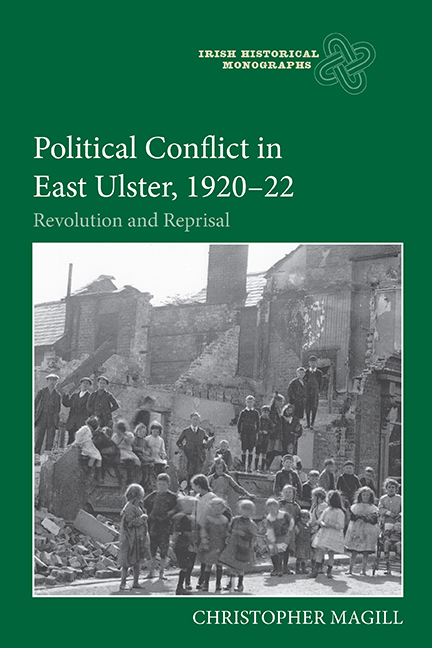Book contents
- Frontmatter
- Dedication
- Contents
- List of Illustrations
- Acknowledgements
- Abbreviations
- A Note on Terminology
- Map
- ‘Cork Justice Travelled a Long Way’: the Assassination of District Inspector Oswald Swanzy
- 1 From Moderates to Militants: the Unionist Community in East Ulster
- 2 Reprisal: the East Ulster Riots
- 3 ‘A Vital But Unenviable Task’: Understanding Loyalist Violence
- 4 A Protestant Force: the Social Composition of the B Specials
- 5 The Wilder the Better? Explaining the Violence of the Ulster Special Constabulary
- 6 A Misunderstood Minority: Irish Nationalists
- Conclusion
- Bibliography
- Index
- Irish Historical Monographs Previous Volumes
5 - The Wilder the Better? Explaining the Violence of the Ulster Special Constabulary
Published online by Cambridge University Press: 21 October 2020
- Frontmatter
- Dedication
- Contents
- List of Illustrations
- Acknowledgements
- Abbreviations
- A Note on Terminology
- Map
- ‘Cork Justice Travelled a Long Way’: the Assassination of District Inspector Oswald Swanzy
- 1 From Moderates to Militants: the Unionist Community in East Ulster
- 2 Reprisal: the East Ulster Riots
- 3 ‘A Vital But Unenviable Task’: Understanding Loyalist Violence
- 4 A Protestant Force: the Social Composition of the B Specials
- 5 The Wilder the Better? Explaining the Violence of the Ulster Special Constabulary
- 6 A Misunderstood Minority: Irish Nationalists
- Conclusion
- Bibliography
- Index
- Irish Historical Monographs Previous Volumes
Summary
I
On 30 June 1922 the Ballymena Observer reported the following story under the headline ‘I.R.A. ATTACK IN CUSHENDALL MAIN STREET’:
At 11 p.m. on Friday night [23 June] a mixed patrol of military and police was ambushed by I.R.A. at Cushendall, County Antrim. Four of the I.R.A. were killed. There were no casualties among the Crown forces
The Crown forces left Ballymena shortly after nine o’clock. All went well until they reached Cushendall village, which the Specials entered in advance of the military, when it is stated, shots were fired by a group of men numbering about thirty standing near the corner at the old Curfew Tower.
The Specials at once dismounted and returned the fire. The military had by this time arrived on the scene, and soon a desperate fight was in progress, in the course of which four men were killed, and three were seen to fall wounded. The names of the killed were John Hill, P. McCurry, John Gore, and – McAllister. The wounded included Daniel O’Loan and John McCallum. The dead were discovered by the Crown forces on making a search of the village. They were not found in the open.
Easily missed by an inattentive reader, this brief report was not prominently displayed, as if to suggest that the event was of little more than local importance. But its ripples would be felt across Northern Ireland and the Irish Sea, prompting unease in ministerial circles in Belfast and London. These misgivings concerned the fate of ‘McAllister’ who, it was rumoured, had been picked up by the Specials on their journey to Cushendall only to end up dead after their arrival at the village. The question of how a prisoner could be killed while in custody arose at the inquest into the deaths of the three (not four as stated in the Ballymena Observer) Cushendall men when the A Specials involved were called to give evidence. Although each testified that they had been targeted in an IRA ambush, local opinion believed otherwise. Writing to Winston Churchill, the Northern Ireland nationalist leader Joseph Devlin claimed that the three men had been killed in an unprovoked attack by A Specials.
- Type
- Chapter
- Information
- Political Conflict in East Ulster, 1920–22Revolution and Reprisal, pp. 98 - 137Publisher: Boydell & BrewerPrint publication year: 2020

